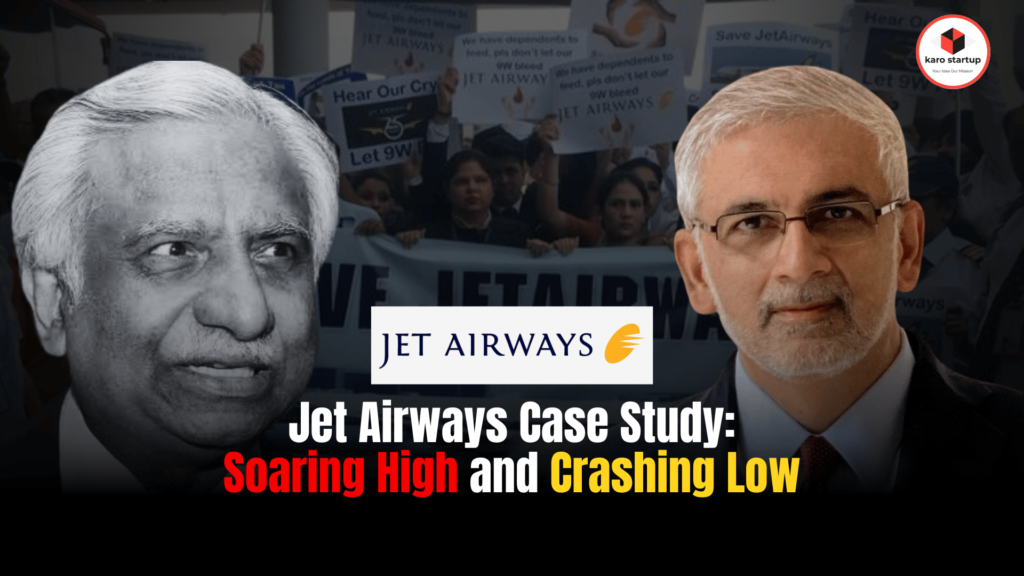Jet Airways, once considered the pride of the Indian aviation industry, stands as a poignant case study of a company that soared to great heights but ultimately crashed and burned.
Established in 1992, Jet Airways embarked on a journey that promised luxury, efficiency, and a new era of air travel in India. However, the airline’s journey was marred by a series of highs and lows, and it serves as a compelling example of both the opportunities and challenges that exist in the aviation industry.
The History & Ascent of Jet Airways
Jet Airways’ history is a rollercoaster ride that began in 1993 when Naresh Goyal launched the airline with four leased Boeing 737 aircraft. At first, it symbolized success in India’s domestic airline industry, but troubles started in 2018 when the airline deferred its quarterly financial results. This raised red flags for government regulators.
In August 2018, the Directorate General of Civil Aviation (DGCA) conducted a financial audit due to concerns about delayed employee salaries impacting morale. The same month, Jet Airways reported a significant loss of INR 1323 crores.

In September 2018, the Income Tax department surveyed the airline’s offices and alleged financial misappropriation. Naresh Goyal and his wife, Anita, who were at the helm of Jet Airways, stepped down in March 2019 as the airline faced a severe financial crisis. They were even prevented from leaving India in May 2019.
Serious charges of money laundering and foreign exchange violations were leveled against Naresh Goyal, leading to investigations by the Enforcement Directorate.
Recent reports suggest that the Central Bureau of Investigation (CBI) might file an FIR against Naresh Goyal for bank fraud and misappropriation of loans, putting the banks and their officials who granted the loans under scrutiny. This tumultuous history serves as a stark lesson in business management and governance.
The Crisis of Jet Airways:
Despite the initial success and growth, Jet Airways faced significant challenges, and its fortunes started to wane. Several factors contributed to the airline’s decline:
1. Financial Troubles:
The aviation industry is capital-intensive, and Jet Airways struggled with mounting debts. The high cost of fuel, increased competition, and economic downturns all took their toll on the company’s finances.
2. Operational Issues:
The airline faced operational inefficiencies and labor disputes, leading to frequent flight cancellations and delays. This eroded passenger trust and tarnished the airline’s reputation for punctuality and service.
3. Regulatory Hurdles:
The Indian government’s stringent policies, such as the 5/20 rule (which required airlines to have five years of domestic operations and 20 aircraft in their fleet before flying international routes), restricted Jet Airways’ international expansion. This rule hindered the airline’s growth and limited its ability to compete effectively on the global stage.
4. Competition:
The Indian aviation sector became increasingly competitive, with low-cost carriers gaining prominence. Jet Airways struggled to adapt to this changing landscape, as budget airlines offered cheaper fares and attracted price-sensitive travelers.
5. Rising Costs:
Jet Airways faced the challenge of rising operating costs, particularly fuel costs, which account for a significant portion of an airline’s expenses. Fluctuations in oil prices could lead to financial instability.
The Descent of Jet Airways
- The culmination of these challenges led to a downward spiral for Jet Airways. In 2019, the airline suspended operations due to its inability to meet financial obligations.
- This unprecedented event marked a turning point in the Indian aviation industry. Thousands of employees found themselves without jobs, and passengers were left stranded.
- Jet Airways’ downfall also had ripple effects on its suppliers, shareholders, and the broader economy.
The Downfall of Jet Airways
The downfall of Jet Airways had far-reaching consequences, affecting various stakeholders, the Indian aviation industry, and the economy as a whole.
Let’s explore the consequences of the airline’s collapse:
- Economic Impact: The aviation industry is intricately connected to various sectors of the economy. The collapse of Jet Airways had a ripple effect on suppliers, service providers, and even tourism. Companies that had business relationships with the airline, such as suppliers of goods and services, faced financial losses.
- Decreased Competition: The absence of Jet Airways from the market reduced competition among airlines. This led to concerns of higher airfares and reduced options for passengers. Competition in the aviation sector can lead to better service quality and more affordable fares for travelers.
- Impact on Air Travel: The halt of Jet Airways’ operations created chaos for travelers. Passengers who had booked flights with the airline were left stranded or had to make alternative arrangements. This highlighted the importance of ensuring passenger protection and mechanisms for dealing with such situations.
- Loss of Investor Confidence: The Jet Airways case had a negative impact on investor confidence in the Indian aviation sector. It served as a stark reminder of the financial instability that can exist within the industry, discouraging potential investors from committing capital.
Jet Airways Efforts to Revive
Despite the dire situation, there have been attempts to revive Jet Airways. Potential investors expressed interest in resurrecting the airline and rejuvenating its brand.
However, these efforts were fraught with legal and financial complexities, further complicating the process of revival.
The ongoing COVID-19 pandemic added another layer of uncertainty to the situation, as the aviation industry worldwide struggled to cope with the fallout.
Lessons Jet Airways Learned By The Downfall:
The Jet Airways case study offers several valuable lessons for businesses, especially in the aviation sector:
- Financial Management: Maintaining sound financial health is critical. Companies should be cautious about taking on excessive debt, and they must have effective financial management strategies in place.
- Adaptability: The aviation industry is dynamic and subject to numerous external factors. Airlines must be adaptable and responsive to changing market conditions and customer preferences.
- Government Policies: Understanding and navigating government regulations and policies is essential. These can significantly impact an airline’s growth prospects and overall viability.
- Competition: Companies must be vigilant about their competitors and continuously seek ways to differentiate themselves and offer unique value to customers.
- Customer Trust: Building and maintaining trust with customers is vital. Once that trust is lost, it can be challenging to regain.
The Future Plans of Jet Airways
Jet Airways has taken a significant step towards its future by appointing Sanjiv Kapoor as its new CEO in March 2022. This move signals that the airline, which faced financial troubles and stopped flying in 2019, is on its way to making a comeback. The revival of Jet Airways is being overseen by the Kalrock-Jalan consortium.
Here are some key points about the future plans of Jet Airways:
1. New Leadership:
With the appointment of Sanjiv Kapoor as CEO, Jet Airways has a fresh leader to guide its revival. Kapoor’s experience and expertise in the airline industry will play a crucial role in shaping the airline’s future.
2. Court-Monitored Restructuring:
Jet Airways is going through a court-monitored restructuring process. This means that legal authorities are overseeing the company’s efforts to get back on its feet, ensuring that everything is done correctly and fairly.
3. Hybrid Services:
The revived Jet Airways is planning to offer a blend of premium and no-frills services. This means that passengers will have different options to choose from, depending on their preferences and budgets.
4. Two-Class Configuration:
- Jet Airways will operate with a two-class configuration. The business class will provide premium services, which may include free meals and other amenities.
- On the other hand, the economy class will operate more like low-cost carriers, where passengers will need to pay for their meals and extras.
5. Reviving Trust:
- After facing financial difficulties and a pause in operations, Jet Airways aims to regain passengers’ trust. This involves ensuring high-quality services, punctuality, and competitive pricing to attract travelers.
- In essence, Jet Airways is making a comeback with a focus on providing a range of services to suit different types of passengers. The airline’s future plans under new leadership and with a court-monitored restructuring process aim to bring back the iconic airline and offer travelers a choice of premium and budget-friendly options for their journeys.
Some Related Posts
Wrapping Up
Jet Airways’ rise and fall is a case study that exemplifies the complexity of the aviation industry and the challenges faced by businesses in a dynamic and competitive market. While the airline once soared to great heights, it ultimately succumbed to a series of challenges, leading to its temporary suspension of operations.
The lessons from Jet Airways’ journey serve as a cautionary tale for both established and emerging businesses. Sound financial management, adaptability, understanding of government policies, competition awareness, and the nurturing of customer trust are all critical factors for success in the aviation industry, and indeed, in any industry.
As the aviation industry continues to evolve and adapt to new challenges, the story of Jet Airways remains a powerful reminder of the highs and lows that companies can experience in their quest for success. It is also a testament to the resilience and determination required to navigate through turbulent skies.
Frequently Asked Questions (FAQs)
Q1. What led to the downfall of Jet Airways in the first place?
Jet Airways faced financial difficulties, rising debts, operational issues, and increased competition, leading to its suspension of operations in 2019.
Q2. Who is overseeing the revival of Jet Airways?
The revival of Jet Airways is being overseen by the Kalrock-Jalan consortium, and the process is court-monitored to ensure transparency and fairness.
Q3. When did Jet Airways appoint its new CEO, and who is the CEO?
Jet Airways appointed Sanjiv Kapoor as its new CEO on March 4, 2022.
Q4. What is Jet Airways’ future service plan?
Jet Airways plans to offer a mix of premium and no-frills services. They will have a two-class configuration, with business class passengers receiving premium services, while the economy class will be similar to low-cost carriers.
Q5. Are there plans for international routes and expansion?
The details about international routes and expansion are not mentioned in the provided information, but it’s a possibility once the airline resumes operations.




